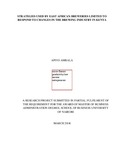| dc.description.abstract | In the ever changing industry environment, any company that wants to be successful and
remain competitive has to have a strategy to ensure this. Every company must be willing and
ready to modify its strategy in response to changing conditions, advancing technology, the
fresh moves of competitors, shifting buyer needs etc. The brewing industry in Kenya has gone
through some changes in the last few years, thus this research set out to find out the external
changes in the brewing industry in that are affecting East African Breweries Limited and the
strategies the company is using to navigate through.
This research project used a case study research design on East African Breweries Limited. The
primary data was obtained from directors and senior managers with the use of an interview
guide. The interview guide was used to gather data on the study topic which was the strategies
used by East African Breweries Limited in responding to changes in the brewing industry in
Kenya. A total of 6 interviewees were targeted however the researcher managed to interview 5.
The secondary data for this study was obtained from newspapers, websites and any other
relevant information.
The data was analyzed using content analysis due to the fact that it was qualitative in nature.
And the findings were discussed on the environmental changes and the strategies put in place to
navigate these changes. The study found that not all the changes affect the company with the
same intensity, therefore they respond to those which are deemed to have a greater impact on
the success and operations of the firm.
The firm continues to be cognizant of the fact that some of the changes that are seen as low risk
now may become high risk in the future.
The study found that not all the forces are considered of equal risk to the company with some
classified as high risk to others classified as low risk. The threat of new entrants was considered
as a high risk due to favorable government policies that were attracting the new entrants.
Bargaining power of buyers was not seen as a high risk due to the fact that they were many
however, the company was also aware off the growing influence of the bar owner associations
being formed in different areas and the potential of their growing influence. The bargaining
power of suppliers was seen as high due to the few number of suppliers of the raw materials
and their influence in the industry operations. The threat of substitutes was not seen as a risk
due to the lack of a substitute product from another industry that would provide similar if not
better benefits than alcohol. The level of rivalry in the industry was also seen to be increasing
due to the level of investment that competitors were setting. This can be seen from the level of
above and below the line advertising they are investing in, the innovations they are coming up
with.In addition the study established that EABL had put in place strategies to address the risks
identified such as for the threat of potential entrants, the firm was investing a lot in keeping
abreast with the changing consumer trends and needs so that they have innovate products that
will meet the consumer needs. The bargaining power of buyers was seen as a potentials threat
especially with the new county government structure. However on of the strategies they were
using was organizing bar owner meetings in order to keep in touch with their customers and
also being members of bar owner associations so that they are aware of opportunities that
maylie with this group of people.
Strategies that they had put in place to deal with the high bargaining power of suppliers were
vertical integration so that they may be able to control some of their costs. Other strategies they
had put in place were assisting barley farmers get financing so that they can be assured of
consistent barley for brewing. A threat of substitutes was not seen as a risk thus the company
did not have any strategy to deal with it. For the rivalry among existing firms, the company was
continuously innovating new products such as Snapp, dark extra, Jebel, increasing investment
in sales and marketing by having more national consumer promotions and leveraging on the
company’s strength in beer to build more scale in spirits.
This study concluded that East African Breweries Limited seems to be doing a commendable job
in responding to the environmental changes the brewing industry is going through. It is evident
that the firm is conscious of the importance of strategic planning in a changing environment such
as the brewing industry in line with Porter’s five forces model. | en_US |

